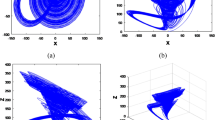Abstract
The construction of the measurement matrix is the key technology for accurate recovery of compressed sensing. In this paper, we demonstrated correlation properties of nonpiecewise and piecewise logistic chaos system to follow Gaussian distribution. The correlation properties can generate a class of logistic chaotic measurement matrices with simple structure, easy hardware implementation and ideal measurement efficiency. Specifically, spread spectrum sequences generated by the correlation properties follow Gaussian distribution. Thus, the proposed algorithm constructs chaos-Gaussian matrices by the sequences. Simulation results of one-dimensional signals and two-dimensional images show that chaos-Gaussian measurement matrices can provide comparable performance against common random measurement matrices. In addition, chaos-Gaussian matrices are deterministic measurement matrices.










Similar content being viewed by others
REFERENCES
S. Serikawa and H. Lu, “Underwater image dehazing using joint trilateral filter,” Comput. Electr. Eng. 40 (1), 41–50 (2014).
H. Lu, Y. Li, et al., “Motor anomaly detection for unmanned aerial vehicles using reinforcement learning,” IEEE Internet Things J. 5 (4), 2315–2322 (2017).
H. Lu, Y. Li, et al., “Brain intelligence: Go beyond artificial intelligence,” Mobile Netw. Appl. 23 (2), 368–375 (2018).
H. Lu, B. Li, et al., “Wound intensity correction and segmentation with convolutional neural networks,” Concurrency Comput. Pract. Exper. 29 (6), e3927 (2016).
H. Lu, Y. Li, et al., “Low illumination underwater light field images reconstruction using deep convolutional neural networks,” Future Gener. Comput. Syst. 82, 142–148 (2018).
E. J. Candès and T. Tao, “Decoding by linear programming,” IEEE Trans. Inf. Theory 51 (12), 4203–4215 (2005).
Q. Wang, M. Wei, et al., “Joint encryption and compression of 3D images based on tensor compressive sensing with non-autonomous 3D chaotic system,” Multimed. Tools Appl. 77 (2), 1715–1734 (2017).
N. Alemazkoor and H. Meidani, “A near-optimal sampling strategy for sparse recovery of polynomial chaos expansions,” J. Comput. Phys. 371, 137–151 (2018).
H. Yu, G. Cao, L. Burk, Y. Lee, J. Lu, P. Santago, O. Zhou, and G. Wang, “Compressive sampling based interior reconstruction for dynamic carbon nanotube micro-CT,” J. Xray Sci. Technol. 17 (4), 295–303 (2009).
D. Xie, H. Peng, L. Li, and Y. Yang, “Semi-tensor compressed sensing,” Digital Signal Process. 58, 85–92 (2016).
L. Li, D. Xu, H. Peng, J. Kurths, and Y. Yang, “Reconstruction of complex network based on the noise via QR decomposition and compressed sensing,” Sci. Rep. 7 (1), 15036 (2017).
L. Yu, J. P. Barbot, G. Zheng, and H. Sun, “Compressive sensing with chaotic sequence,” IEEE Signal Process. Lett. 17 (8), 731–734 (2010).
J.-B. Guo and R. Wang, “Construction of a circulant compressive measurement matrix based on chaotic sequence and RIPless theory,” Acta Phys. Sin. 63 (19), 198402-1–198402-10 (2014) [in Chinese].
L. Bin and P. Yulou, “Composition algorithm for compressed sensing measurement matrix based on chaotic sequences,” Comput. Eng. Appl. 49 (23), 199–202 (2013) [in Chinese].
R. Parvaz and M. Zarebnia, “A combination chaotic system and application in color image encryption,” Opt. Laser Technol. 101, 30–41 (2018).
J. Castorena and C. D. Creusere, “The restricted isometry property for banded random matrices,” IEEE Trans. Signal Process. 62 (19), 5073–5084 (2014).
D. Sundman, S. Chatterjee, and M. Skoglund, “A greedy pursuit algorithm for distributed compressed sensing,” in Proc. 2012 IEEE Int. Conf. on Acoustics, Speech and Signal Processing (ICASSP) (Kyoto, Japan, 2012), pp. 2729–2732.
M. Suchithra, P. Sukanya, et al., “An experimental study on application of Orthogonal Matching Pursuit algorithm for image denoising,” in Proc. 2013 Int. Multi-Conference on Automation, Computing, Communication, Control and Compressed Sensing (iMac4s) (Kottayam, India, 2013), IEEE, pp. 729–736.
X. F. Zhang and J. L. Fan, “A new piecewise nonlinear chaotic map and its performance,” Acta Phys. Sin. 59 (4), 2298–2304 (2010) [in Chinese].
L. Cong and S. Songgeng, “Correlation distribution of spreading sequences based on logistic maps,” Chin. J. Electron. (1), 140–141 (1999) [in Chinese].
Funding
This work is supported by the North East Petroleum University Natural Science Foundation under Grant nos. 2017PYZL-05, JYCX_CX06_2018, and JYCX_JG06_2018.
Author information
Authors and Affiliations
Corresponding author
Ethics declarations
The authors declare that they have no conflicts of interest.
Additional information

Xiaoxue Kong, born in 1993, received her bachelor degree from the Hebei Normal University of Science and Technology, China, in 2017. Currently, she is a graduate student in North East Petroleum University, China. Her research interests comprise compressive sensing, object recognition and detection, etc.

Hongbo Bi, born in 1979, received his bachelor degree and master degree in communications engineering from North East Petroleum University, China, in 2001 and 2004, respectively. He received his PhD in 2013 from Beijing University of Posts and Telecommunications and worked as a PDF (PostDoc Fellow) in Harbin Engineering University in 2014–2017. He is also worked as a visiting scholar in University of Waterloo (Canada) in 2014–2015. Currently, he is an associate professor in School of Electrical Information Engineering in North East Petroleum University. Hismain research interests focus on saliency detection, compressive sensing, deep learning, digital watermarking, signal processing, etc.

Di Lu, born in 1993, received his bachelor degree from the North East Petroleum University, China, in 2016. Currently, he is a graduate student in North East Petroleum University, China. His research interests vidio saliency detection tasks, etc.

Ning Li, born in 1990, received his bachelor degree from Huanghuai University, China, in 2015. Currently, he is a graduate student in North East Petroleum University, China. His current research interests include saliency detection, face photo-sketch synthesis and deep learning.
Rights and permissions
About this article
Cite this article
Kong, X., Bi, H., Lu, D. et al. Construction of a Class of Logistic Chaotic Measurement Matrices for Compressed Sensing. Pattern Recognit. Image Anal. 29, 493–502 (2019). https://doi.org/10.1134/S105466181903012X
Received:
Revised:
Accepted:
Published:
Issue Date:
DOI: https://doi.org/10.1134/S105466181903012X




